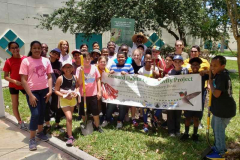We have much more to do and your continued support is needed now more than ever.
Tree Equity in Broward County

Three years ago, the National Wildlife Federation and NatureScape Broward (part of the Broward County Environmental Planning and Community Resilience Division) came together to launch a new project to help migratory birds and people by planting native trees in this densely populated county in Southeast Florida.
This new project built upon a successful decade of partnership between National Wildlife Federation and Broward County and a need to bolster urban habitat for migratory birds in this section of the Atlantic Flyway.
To identify the areas with the lowest tree canopy, the County created a series of maps using GIS software that showed the 32 cities within Broward County and their percentage of tree canopy, amount of green space and other indicators of a healthy urban environment.
We found that certain communities in central, inland Broward County had less tree canopy than the rest of Broward County. These cities also had some of the lowest income per capita in the region. Basically, your zip code or wealth is correlated to the number of trees you have (or don’t have) in your community.
Tree equity is an important environmental justice issue in Broward County.
While trees are critical for wildlife like migratory birds, the presence of tree canopy is also correlated with improved human health outcomes, cleaner water, and reductions in the urban heat island effect – the phenomenon where human-made surfaces like asphalt and concrete absorb and radiate heat, increasing temperatures of urban areas.
This correlation between wealth and tree canopy is evident in studies from Washington, DC to Los Angeles County, CA, and other parts of the country as well. A multi-city study conducted in 2015 and led by Kirsten Schwarz, assistant professor of biology at Northern Kentucky University, resulted in this conclusion:
“Money may not grow on trees, but this study suggests that in a way, trees grow on money. Our findings show that high-income neighborhoods in our selected cities are more likely than low-income neighborhoods to have high tree canopy cover.”
In the last three years, with support from the Community Foundation of Broward, Broward County Public Schools, the National Wildlife Federation and NatureScape Broward have worked closely with the cities of Lauderdale Lakes, North Lauderdale, Lauderhill, Sunrise, Tamarac and Margate to engage residents in learning about and planting native trees throughout the community. Together, in the last three years we have:
1) Installed 15 “Broward Habitat Connectivity Project” sites. These are major habitat improvements with large native trees planted with residents at local parks and schools.
2) Given away or planted 30,000 native trees through more than 50 public events and educational workshops.
3) Registered the cities of Lauderdale Lakes, North Lauderdale, Lauderhill, Sunrise, Tamarac and Margate in the National Wildlife Federation’s Community Wildlife Habitat program to make their communities greener and increase tree canopy over the long-term.
Together we are working to address the inequitable distribution of tree canopy in Broward County and at the same time helping to address the impacts of the extinction crisis and global climate change.






















